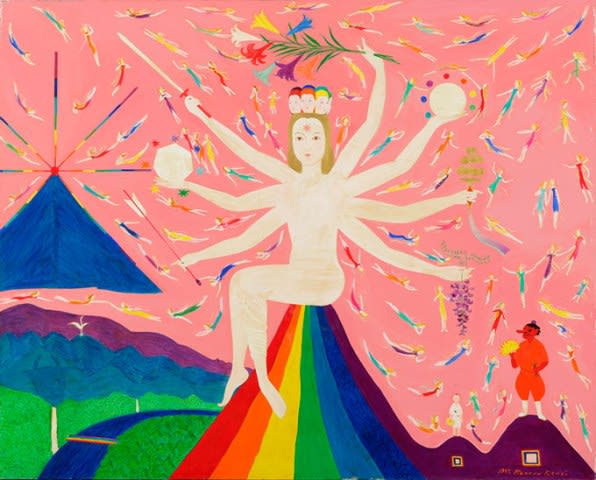
After visiting the Ama-no-hitsugu Shrine, I went to
Kawamura Mermorial DIC Museum of Art in Sakura-city, Chiba. I really had to go
and see the exhibition they were showing only during this period.
The exhibition was displaying works of Nanryu Kanai,
Tenmei Okamoto, Kumagusu Minakata, Nao Deguchi. These people are the four major
ones who were involved in the revolution of spirituality in Japan during the
Meiji to Showa era. Whoever came up with this idea to bring these four in one exhibition
must really know something or it was god's will. It is highly unusual to plan
something like this. (The painting shown above is from the homepage of
the museum. Painted by Nanryu Kanai 1987. ”The middle day of the equinoctial
week receiving the ray of the sun from top of Mt.Fuji to Mt.Shichimen”)
I want to first talk about Nanryu Kanai.
Around age 20, I started to visit Shinto shrines in
Kinki district. I met numerous people at the shrines who self-claim to be a
god's worker, who receives revelations and do sacred rituals accordingly.
During those time around the Show period (1970~80s), spirituality was not just
a light trendy thing, and there were quite a few who were seriously involved,
even very odd or suspicious looking and seriously crazy wanderers.
When
I visited the shrines, I often got caught by this kind of people. They would
come to talk to me. I was still young and I thought it would be rude to ignore
them. So I used to sit on a bench and just talked to them. And in the
conversations I had, Nanryu Kanai was often spoked about. During the Show 40s
(1965~75), Nanryu Kanai used to enter the sacred territory, the taboo where
people used to fear and say, "you will die if you try to
enter that realm."
Nanryu was one of the first of the god's worker and
he started to talk about divine missions, the sacred ties, the divine system, etc. His character is quite the opposite from me but in the same sense we could
both disturb the sacred or the god's realm and not die. We are both unaffected
by those who are involved in the cursing war. I was very interested
in him because of these unique qualities.
The economy was booming during the Showa period and
he had also reached success in business at that time. He also used his psychic
ability to foresee the stock rates and made quite a lot of money. In many
ways, he was one of the great Showa guy in my opinion.
As for his spiritual back ground, I sense that he
has something to do with Susanoo in the foreign country. A Chinese charter
of 白
(white) comes into my mind.
Nanryu
Kanai's work is very colorful. He also loved women and enjoyed his godly
missions. This kind of exotic quality is very Showa like. Another reason
why I find his painting very capturing is because he often draws a Tengu (a
retainer of god in a form of a crow) in his work. He and I come from a
very different spiritual background, but looking at the colors he uses, I
can tell that he is not a fraud. This painting really captures the scent of
Showa and reminded me of the good old days.
The Important thing is to create your own original belief and to have your faith in your way. The sense of gratitude should be the center pole in your faith. Then there is nothing to worry about. The best way is to send gratitude to your ancestors in your own way .
The Important thing is to create your own original belief and to have your faith in your way. The sense of gratitude should be the center pole in your faith. Then there is nothing to worry about. The best way is to send gratitude to your ancestors in your own way .
He, Nanryu Kanai also had his own religion "you
be your own priest of life." He was a true pathfinder. A man of what
we call 海千山千 (umisen-yamasen), a man who has a lot of experience in both of the sides
of a coin as if he has lived a thousand years in the ocean and a thousand years
in the mountain.
Ikashite-itadaite Arigato-gozaimasu
Thank you for letting us live
生かして頂いて ありがとう御座位ます


No comments:
Post a Comment